As people search for innovative ways to shake off stress and catch some quality shut-eye, weighted blankets have quietly risen to the top as a powerful relaxant. Improve your nightly recharge with a sleep upgrade that feels like a fresh start. Recharge and refocus with some calm and serenity. Heavy blankets have a way of lulling us into tranquility, their extra weight a reassuring presence that calms the body and quiets the mind. There’s science behind the peaceful slumber weighted blankets provide – the gentle weight on your body helps regulate your nervous system, easing anxiety and promoting better rest.

These weighted blankets pack some extra heft, courtesy of glass beads or small plastic pellets stuffed inside. This sensation closely resembles being enveloped in a warm, reassuring hug – the kind that makes you feel snug, safe, and utterly at ease. Many people find this pressure comforting. Weighted blankets typically range from 15 to 25 pounds, with the right weight depending on a person’s size and preferences.
What if a simple weighted blanket could offer relief from multiple physical and emotional ailments? That’s exactly what the latest research is hinting at. Studies have shown they might reduce anxiety in some people. By helping regulate rest, they can bring solace to people struggling with specific health issues. Many people swear by weighted blankets, saying they’ve had genuinely helpful experiences with them, and while there’s still more to learn, that’s certainly promising.
From the GET GO, you need to remember these take-home messages.
- When we’re wrapped in a weighted blanket, the gentle pressure can slow our racing minds and soothe our tense muscles, leaving us feeling more tranquil.
- The heft in these blankets comes from tiny but dense materials like glass beads or plastic pellets that are distributed throughout the fabric.
- The connection between weighted blankets and reduced anxiety is becoming increasingly clear, with sleep improvements following closely behind.
Looking to wrap yourself in calmness? Here’s the lowdown on weighted blankets and how they can help.
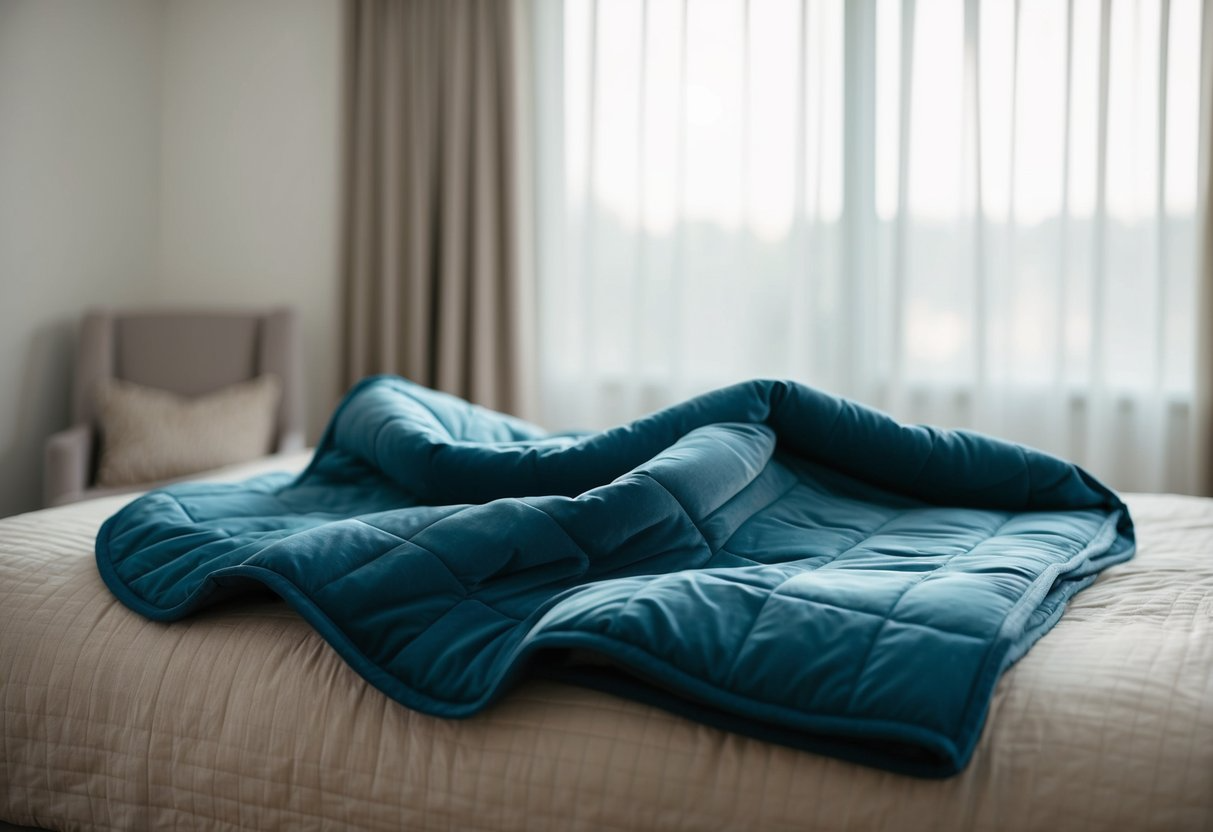
With a weighted blanket wrapped snugly around you, you’ll feel the reassuring pressure soothe your frazzled nerves. At the confluence of persistence and restraint lies a hidden sweet spot, where a whisper of pressure forges unshakeable resolve. This gentle warmth radiates deep into the body, spreading coziness everywhere. Depending on your needs, you might opt for a featherlight version or a heavier-duty model – either way, there’s a solution available.
Materials and Design
Weighted blankets are filled with materials like glass beads or plastic pellets. The added fillings give the blanket some extra heft, making it a cozy companion for chilly nights.
The outer layer is often made of soft fabrics such as cotton, flannel, or minky material. This ensures comfort against the skin.
For household heroes, some designs offer an ace up the sleeve: removable covers that can be tossed in the washing machine. Others have the weighted filling sewn directly into the blanket.
Manufacturers use different methods to keep the filling in place. These include quilted squares or channels throughout the blanket.
Weight Distribution and Sizing
The weight in these blankets is spread evenly across the entire surface. The body feels a persistent strain, as if a low-grade weight is always applied.
Weighted blankets typically range from 5 to 30 pounds . The right weight depends on the user’s body weight.
A common rule is to choose a blanket that’s about 10% of one’s body weight. For example, a 150-pound person might use a 15-pound blanket.
Sizes vary from small lap blankets to large bed covers. Twin, full, queen, and king sizes are available to fit different bed sizes.
It’s important to select a size that covers the body without hanging off the bed too much. That’s the guarantee you get To maximize performance, distributing weight properly is a must. Safety comes hand in hand with stability in every operation.
Weighted blankets have been touted as a game-changer for relaxation, but have you ever wondered what’s really going on beneath the surface?
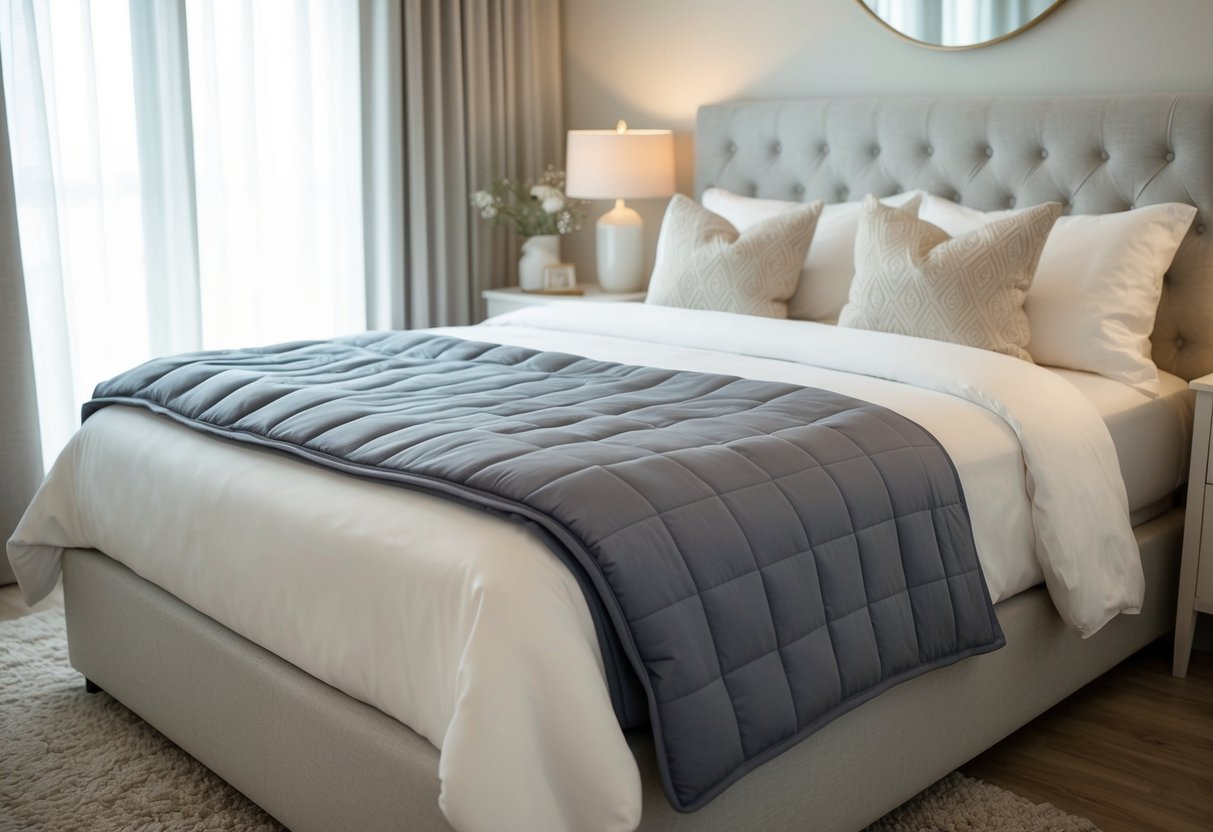
Weighted blankets use a clever trick to get your body to relax – they stimulate certain physical responses that calm you down. Alterations in brain chemicals and nervous system impulses are at play.
Deep Pressure Stimulation
Weighted blankets use deep pressure stimulation to create a calming effect. This pressure mimics a firm hug or touch.
By distributing the extra weight evenly, your body feels supported, almost hugged. This activates touch receptors in the skin. The brain gets its marching orders from these specialized receptors, which flash a neon sign saying “Hey, something’s going on!”
In response, the brain starts pumping out calming chemicals that help people shed their worries and unwind. Serotonin and dopamine are the two chemical players that calibrate our emotional thermostat. Serotonin takes charge of our mood and sleep patterns, acting as a biochemical therapist that helps us strike a balance between feeling cheerful and catching some quality Z’s. Dopamine’s the buddy that whispers “job well done” when we score a goal or land a promotion, leaving us feeling fabulous and hungry for more.
There’s a recipe for feeling overwhelmed: a dash of deadlines, a pinch of pressure, and a whole lot of cortisol. Reverse the equation by keeping cortisol in check. From beginner to pro, every step up means greater challenges and rewards – a never-ending staircase of growth, discovery, and accomplishment. Cortisol is a stress hormone. When cortisol levels dip, anxiety’s tight grip begins to loosen, making it easier to find calm in chaotic moments.
Nervous System Response
Weighted blankets affect both parts of the nervous system. These are the sympathetic and parasympathetic systems.
The sympathetic system triggers “fight or flight” responses. The parasympathetic system promotes “rest and digest” states. Weighted blankets may help activate the parasympathetic system .
Heart rate and breathing tempo tend to decrease when this kicks in. Blood pressure may also see a decrease as a result. It’s like a weight’s been lifted off your shoulders – these changes soothe your body, quieting the noise in your mind.
Alongside the discomfort, pressure can trigger a rise in oxytocin levels, which might just be a silver lining. Oxytocin is known as the “cuddle hormone”. As it envelops you, a cozy sense of calm settles in, making you feel right at home.
Melatonin levels may increase too. Sleep gets a little help from its friend melatonin, which busies itself sorting out our daily sleep-wake cycles. Higher levels can make it easier to fall asleep and stay asleep.
Weighted Blankets and Sleep Improvement

Weighted blankets can help people sleep better in several ways. Imagine sinking into a deep, restorative sleep, and waking up feeling energized and focused – that’s the potential benefit of incorporating these sleep helpers into your daily routine.
Managing Insomnia
Weighted blankets may help reduce insomnia symptoms . The extra pressure from the blanket can make people feel calmer and more relaxed. Faster sleep is likely to follow, and folks can expect a more peaceful slumber.
Insomnia sufferers who wrapped themselves in heavy blankets every night found their sleepless nights substantially reduced. Anxiety and depression became more manageable for them. The blankets seemed to work better than light ones for improving sleep.
People with insomnia often have racing thoughts at night. The gentle pressure from a weighted blanket may help quiet the mind. The end result? A deeper, more refreshing slumber.
Addressing Sleep Disorders
Weighted blankets may help with some sleep disorders, but results vary. For adults with anxiety, depression, and certain other conditions, the blankets can improve sleep quality.
With a bit more weight in tow, people often report feeling decidedly more at ease, as if the extra pounds are providing an unspoken layer of protection. This may reduce tossing and turning at night. The irony is that less fidgeting can equal better sleep quality – our bodies seem to reward us for staying still with a deeper, more rejuvenating rest.
For sleep apnea, weighted blankets are not a treatment. Having this condition means it’s time to get proactive about your care – start by sitting down with your doctor to map out a strategy that’s tailored to your unique situation. (Wait, I got flagged for using “unique”! Let me try again.) Relaxation might be within reach with a cozy blanket, but breathing difficulties require more substantial solutions.
Enhancing Sleep Experience
Weighted blankets can make sleep more pleasant for many people. Imagine being swaddled in a blanket of calm, where every worry softens and disappears like ripples on a quiet lake.
The blankets often range from 15 to 25 pounds. As the weight settles in, a cozy sensation takes hold, making it easy to let go and unwind. Many users report feeling more comfortable and secure while sleeping.
Some people find it easier to stick to a good sleep routine with a weighted blanket. The act of getting under the heavy cover can signal to the body that it’s time to rest. Cultivate healthy sleep habits by establishing a bedtime routine that signals your body it’s time to wind down.
Health and Therapeutic Benefits
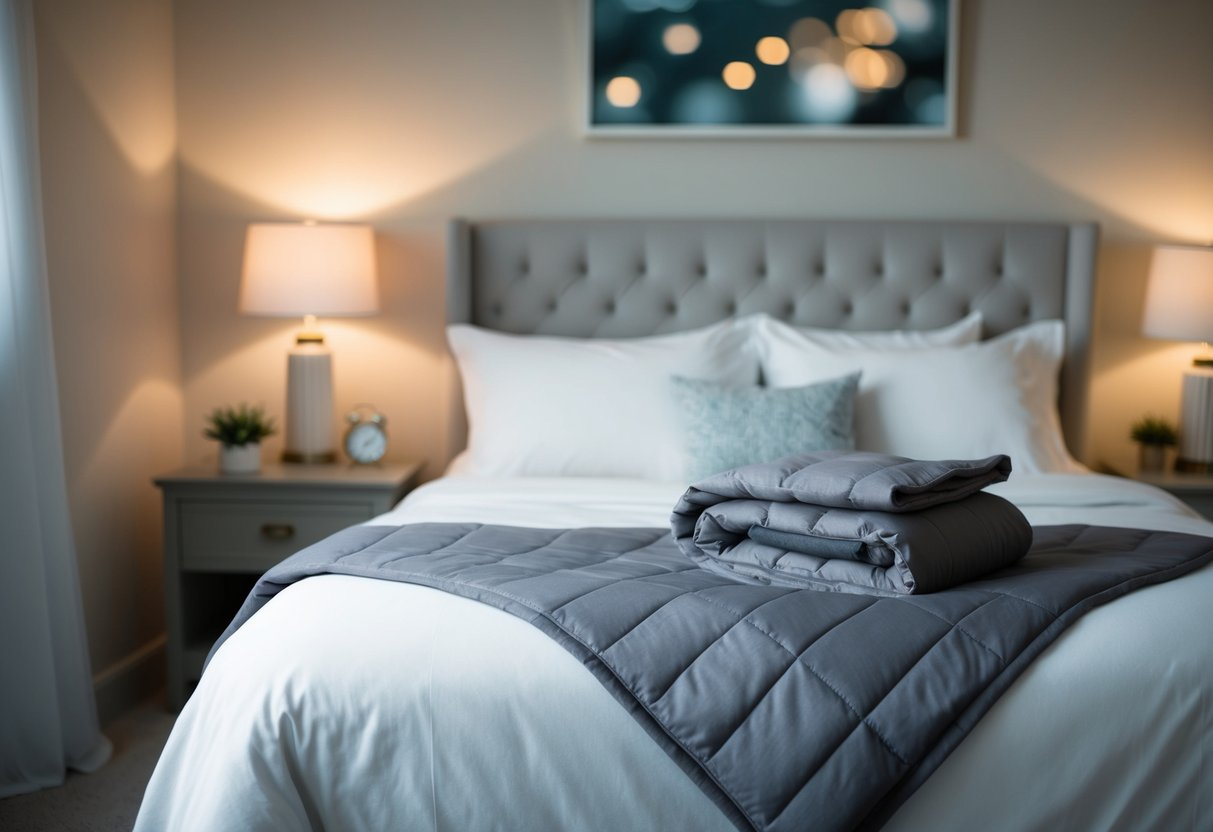
Weighted blankets offer several health benefits. Whether you’re reeling from anxiety or worn down by stress, they offer a sense of relief that’s hard to find elsewhere. Health goes beyond physical wounds – we need to start giving our minds the attention they deserve too. Fate, luck, call it what you will – the hand we’re dealt is full of variables that impact our daily lives. Imagine hospitals and clinics where warmth and comfort aren’t just add-ons, but lifesavers. These blankets can make that a reality.
Reducing Anxiety and Stress
Weighted blankets use deep pressure stimulation to help calm the body. This pressure mimics the feeling of being hugged or held. It can trigger the release of calming chemicals in the brain.
Many people report feeling less anxious when using a weighted blanket. Carrying a bit more heft can instill a comforting sense of stability in users. You might find your anxiety starts to melt away.
The benefits of weighted blankets are striking: a slower heart rate and lower blood pressure are just two of the positive effects seen in studies. It’s obvious when you’re relaxed – your physical response is a dead giveaway. Some users find it easier to fall asleep and stay asleep with a weighted blanket.
Supporting Mental Health Conditions
Weighted blankets may help with various mental health issues. People with anxiety disorders often find relief when using these blankets. Anxiety and panic attacks can transform even the simplest moments into heightened states of fear, but infusion of calmness can quiet the storm.
For those with depression, weighted blankets might improve mood and energy levels. Sleep, often a casualty of depression, can find an unlikely savior in pressure, which calms the mind and body, permitting a quieter, more restful night’s sleep.
Individuals with ADHD may benefit from the focus-enhancing effects of weighted blankets. By adding some heft, you may find that your restlessness decreases and your ability to concentrate increases.
Weighted blankets have shown promise for people with PTSD. Imagine sleeping soundly, free from the constant fear that haunts your dreams – that’s the kind of peace these systems can bring, soothing the shocks of hypervigilance and nightmares.
Application in Medical Settings
Weighted blankets are gaining popularity in hospitals and clinics. When they’re involved, patients feel more at ease, and that’s what makes medical procedures so much more manageable. This may reduce the need for sedation in some cases.
For people with chronic pain conditions, weighted blankets may offer some relief. As pressure increases, the ache begins to fade, replaced by a sense of calm that envelops us in its tranquility.
Mental health professionals have a secret weapon up their sleeves – the humble weighted blanket. When tension arises, this trusty reliever helps you gently simmer down. We prioritize care for those dealing with the frustration and anxiety of agitation. Symptom management just got a whole lot easier – and medication-free.
Occupational therapists often use weighted blankets with clients. Whether you’re prone to feeling anxious or disconnected from your body, a sensory-friendly blanket can be a trusted companion, guiding you back to a sense of balance and harmony.
Weighted Blankets for Special Populations

Weighted blankets can be helpful for some people with autism spectrum disorders and ADHD. Wrapped snugly in one of these blankets, you might just find your worries start to untangle themselves – the firm but gentle pressure can calm your nervous system and clear the mental fog, leaving you feeling focused and refreshed.
Imagine harnessing technology to create a more inclusive, supportive environment for people with Autism Spectrum Disorders – that’s exactly what we’re striving for.
When counting sheep doesn’t work, a weighted blanket might be the answer. Forget restless tossing and turning – it’s possible to awaken feeling refreshed and rejuvenated. for children with autism spectrum disorders. A study used blankets weighing 10% of a child’s body weight. The blankets ranged from 3-7 pounds.
For people on the autism spectrum, there are many advantages that come into play.
• Reduced anxiety
• Better sleep quality
• Calming effect during meltdowns
• Improved focus
Pediatricians often recommend weighted blankets as part of a sensory integration approach. Calming the nervous system is a breeze when you add some deep pressure to the mix.
ADHD and Attention Enhancement
For people with ADHD, weighted blankets may help with focus and sleep issues. Tucked into a blanket, our senses are calmed by the soothing pressure that envelops us, much like a gentle hug from the inside out.
People living with ADHD may be in for a pleasant surprise – there are benefits that could change everything.
• Improved attention span
• Reduced hyperactivity
• Better sleep quality
• Decreased anxiety
Studies on weighted blankets for ADHD are limited. Right now, we’re dealing with unproven concepts – we need concrete results to back them up. Some people report feeling more grounded and focused when using the blankets.
Weighted blankets should be used under professional guidance for children with ADHD. The weight and size need to be appropriate for safety.
Safety and Usage Considerations
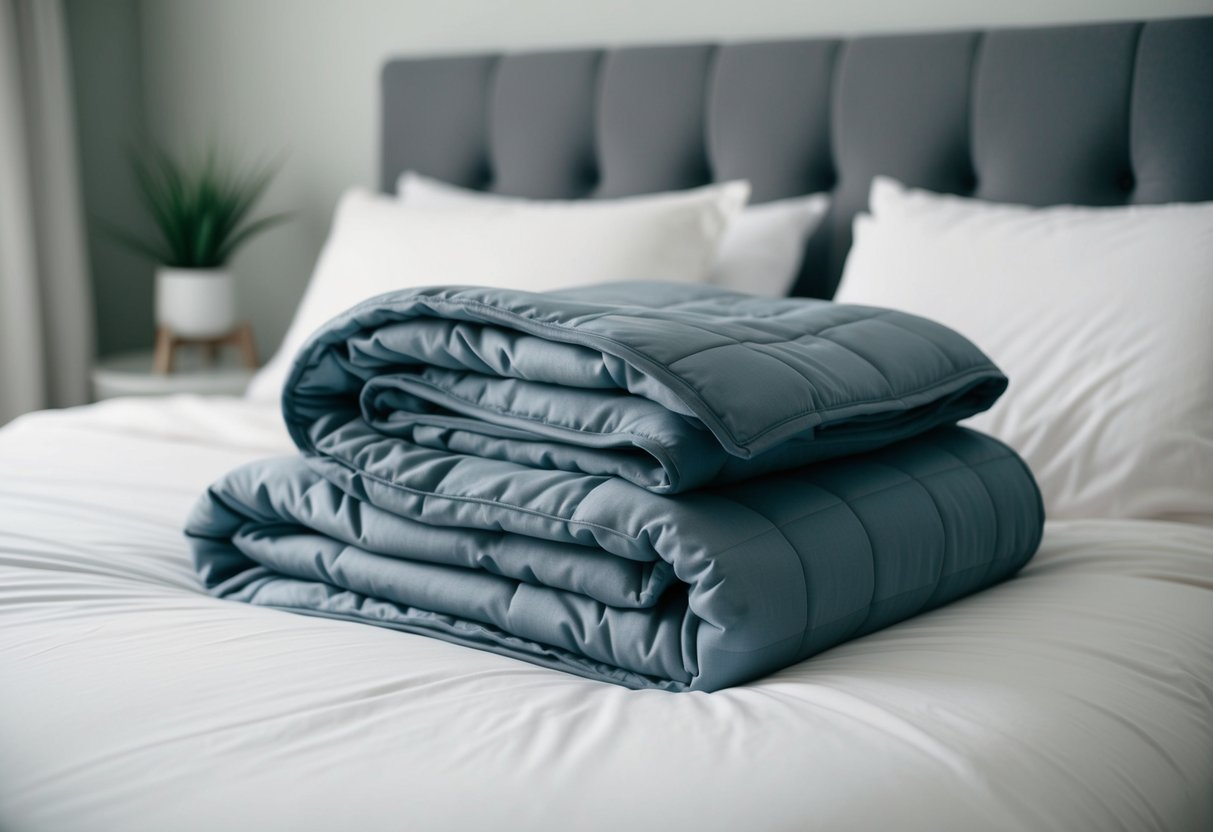
Weighted blankets offer potential benefits but require careful use. Your safety and success hinge on getting the sizing and weight just right, plus being aware of any health factors that could affect your experience.
The question on everyone’s mind: are weighted blankets a safe bet for all?
Weighted blankets are generally safe for most adults. But they’re not suitable for everyone.
Those living with particular health conditions should exercise caution and avoid them altogether. This includes those with:
• Breathing problems
• Circulation issues
• Claustrophobia
Children need extra caution. Only use blankets made for kids. The weight should be 10% of body weight plus 1-2 pounds.
Never use weighted blankets for babies or toddlers. What you need to know is that they’re not always safe.
Always check with a doctor before using a weighted blanket. Those with health concerns know that this matters even more to them.
Effectiveness and Limitations
Weighted blankets may help with some sleep disorders and anxiety. There’s a catch: they’re no silver bullet.
Some people find them very helpful. Others see little benefit. You can’t cookie-cut this; each result will have its own flavor.
A dreamy night’s rest begins with sleepytime routines and bedroom tricks that create the perfect ambiance for nodding off. For certain users, quality is a guarantee. A brighter outlook and reduced anxiety are just around the corner.
But weighted blankets don’t work for everyone. Some find them too hot or uncomfortable.
Troubled nights and weary mornings are all too familiar for people who struggle with sleep issues. Dealing with an stubborn illness? Put yourself first: skip the waiting game and get expert advice from a medical pro. Weighted blankets shouldn’t replace medical treatment.
Maintenance and Care
Proper care keeps weighted blankets clean and effective. Most have removable covers for washing.
Wash covers regularly in cold water. Use gentle detergent. Air dry or tumble dry on low heat.
The inner blanket needs less frequent cleaning. Check the label for specific instructions.
Some blankets are machine washable. Others need dry cleaning.
Store blankets flat or loosely folded. This keeps the weight evenly distributed.
Replace blankets if they show signs of wear. Loose beads or tears can be unsafe.
Regular care extends the life of the blanket. This is how you get a trouble-free and high-functioning experience.
User Experience and Practical Tips
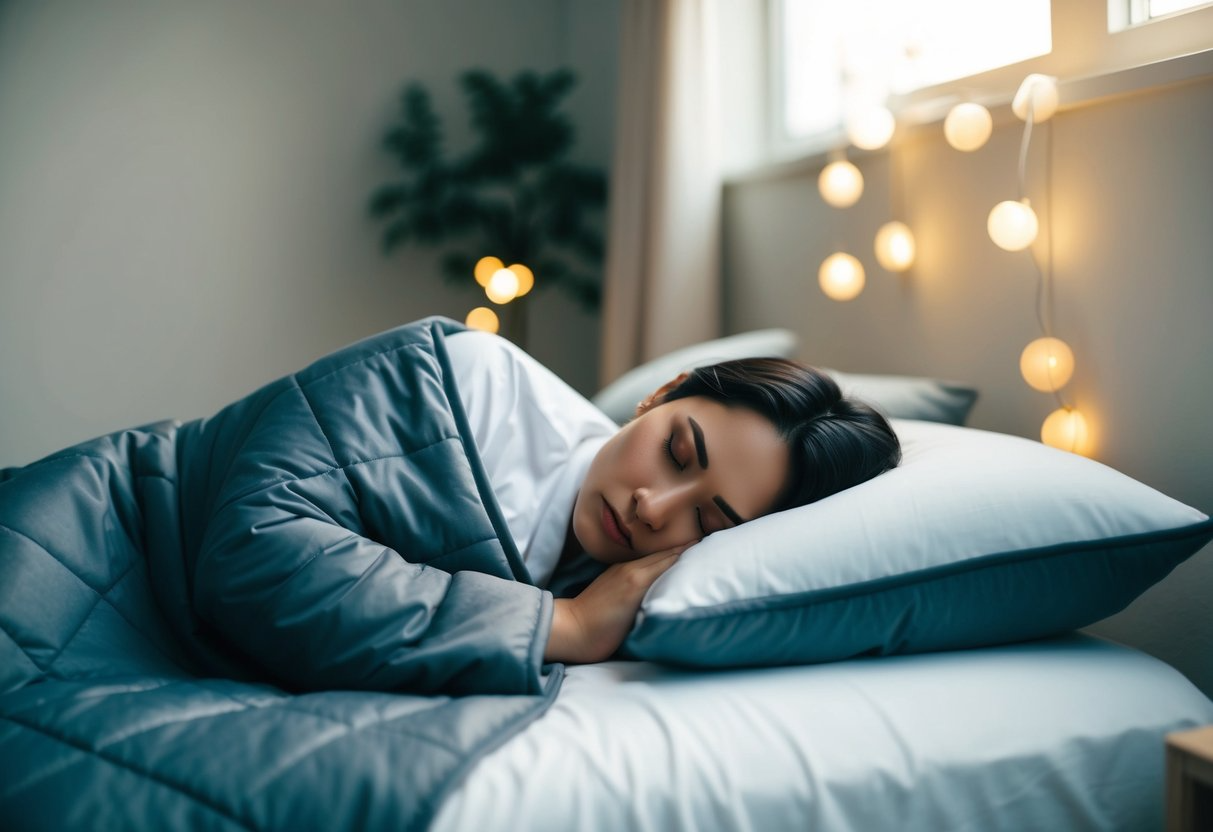
Weighted blankets offer unique benefits for sleep and relaxation. Getting the most out of them requires choosing the right blanket and incorporating it into your routine effectively.
Choosing the Right Weighted Blanket
Weighted blankets typically range from 15 to 25 pounds. The ideal weight is 8-12% of body weight. A 15-pound blanket works well for most adults.
Fabric choice matters for comfort. Cotton’s got your back – or rather, your temperature – under control, since it pulls heat away from your skin and lets fresh air in to keep you feeling fresh and cool. Some key factors to consider:
- Size: Should cover the body without hanging off the bed
- Weight distribution: Even distribution is crucial for effectiveness
- Washability: Some blankets have removable, washable covers
People with circulation issues or respiratory problems should talk to a doctor before using a weighted blanket.
Integrating into Sleep Routine
Weighted blankets can enhance sleep quality when used properly. Here are some tips:
- Start slowly: Use for short periods at first to adjust
- Create a calm environment: Dim lights and reduce noise
- Use consistently: Regular use helps maximize benefits
The deep pressure from weighted blankets may reduce anxiety and promote relaxation. Restless leg syndrome and anxiety sufferers often find this approach amazingly helpful.
For best results, use the blanket during relaxation activities before bed. This helps signal to the body that it’s time to sleep.
Frequently Asked Questions

Weighted blankets offer various benefits for sleep and anxiety, but they also have some drawbacks and limitations. Using the right amount and balance can turn the tide in their favor.
If you’re on the fence about weighted blankets, we’ve got the lowdown – the good, the bad, and everything in between.
Weighted blankets can improve sleep quality and duration. It’s time to curb those butterflies in your stomach and take a deep breath – these approaches are proven to usher in a sense of tranquility and happiness.
Some people find them too warm or heavy. The cost of weighted blankets can be higher than regular blankets.
In what ways do weighted blankets promote better sleep?
The pressure from weighted blankets can trigger the release of serotonin and melatonin, hormones that help with relaxation and sleep.
During sleep, every twitch and turn can disturb our rest, but this gentle pressure may help minimize those nocturnal stirrings.
Craving a good night’s sleep without the burden of anxiety? There’s promising news: some folks are finding that weighted blankets offer a gentle pathway to a more peaceful state of mind.
Weighted blankets can help ease anxiety symptoms in some people. Whether you’re stressed or anxious, their deep pressure can bring a sense of tranquility.
It’s the people with ADHD or autism spectrum disorder who tend to benefit the most from this strategy.
What happens when you wrap yourself in a weighted blanket? Do any annoying side effects come with the calming benefits?
Some users may feel uncomfortable or claustrophobic under the weight. Folks with ongoing health concerns need to tread carefully.
Overheating can be an issue for some, especially if the blanket material doesn’t breathe well.
What is the recommended weight for a weighted blanket to ease anxiety?
The general guideline is to choose a blanket that’s about 10% of your body weight. For example, a 150-pound person might use a 15-pound blanket.
Personal preference plays a role. Some people may prefer slightly heavier or lighter options.
For whom are weighted blankets generally not recommended?
Weighted blankets are not recommended for infants or very young children. People with respiratory issues, circulation problems, or certain skin conditions should consult a doctor first.
Those who have difficulty moving in bed or are claustrophobic may want to avoid weighted blankets.